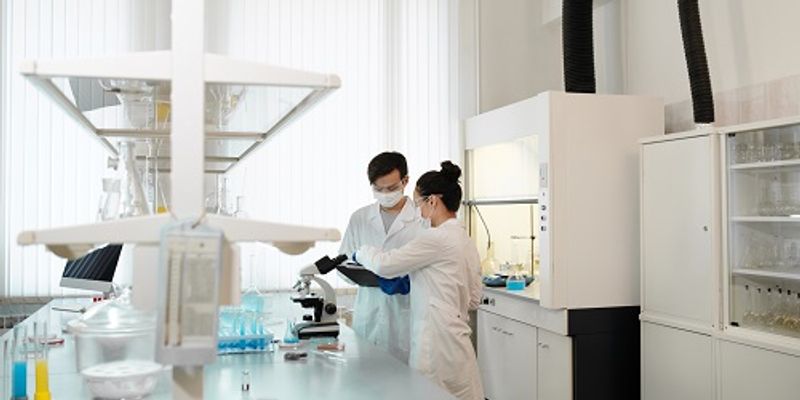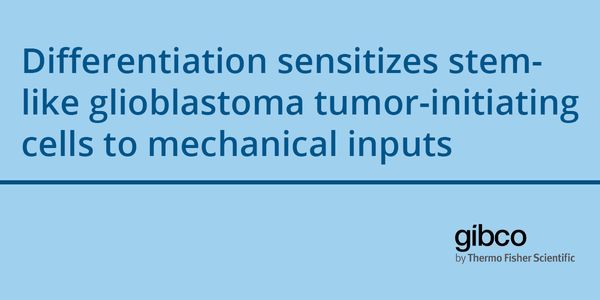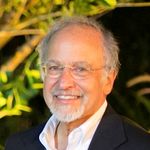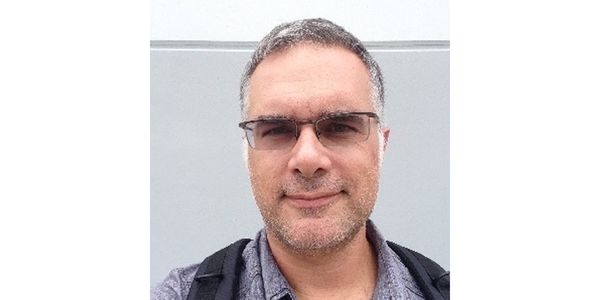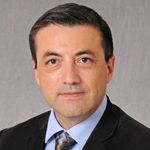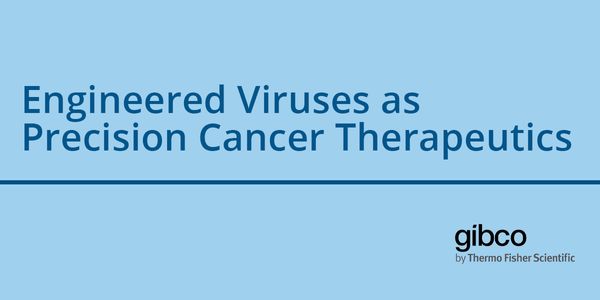Gene and Cell Therapy
With the goal of treating and curing disease, gene and cell therapy provide treatment by means of altering a person's genetic code and transferring live cells to improve symptoms and reduce levels of disease-causing proteins.
-
APR 01, 2018 | 12:00 AMOne would think that getting the diagnosis after fifteen years would end the journey. How does your work at the bench affect patients and how can you change lives through cell therapy? ...MAR 22, 2018 | 9:00 AMDATE: March 22, 2018TIME: 09:00am PST, 12:00pm ESTGlioblastoma (GBM) is the most aggressive primary brain cancer, with nearly universal recurrence after treatment. GBMs are highly heter...MAR 15, 2018 | 10:30 AMThe study of rare, neurological disorder and the development of effect treatments can pose many unique challenges. A paucity of scientists working on these disorders often limits forward prog...MAR 15, 2018 | 9:00 AMThe inability of neurons to regenerate damaged axons within the CNS has dire consequences for victims of traumatic or ischemic brain injury and multiple neurodegenerative diseases. Like other...FEB 28, 2018 | 12:00 AMTBD...FEB 22, 2018 | 10:30 AMPreterm birth (PTB) is the leading cause of infant mortality and morbidity worldwide. Both preterm labor and neonatal injuries have been linked to inflammation. Of all mediators of inflammati...Speaker: Sylvain Chemtob, MD, PhD, FRCPC, FAAP, FCAHSPresented at: Drug Discovery Virtual Event Series 2018
FEB 21, 2018 | 6:00 AMWe recently reported that HDAC6 is involved in the regulation of a number of immunosuppressive checkpoint proteins, including the Program Death Receptor Ligand 1 (PD-L1). This protein is one...JAN 25, 2018 | 10:00 AMDATE: January 25, 2018TIME: 10:00am PST, 1:00pm EST, 6:00pm GMTOncolytic virotherapy, the use of viral vectors to treat cancer, holds huge promise. Viruses are natural DNA delivery vehi...DEC 14, 2017 | 6:00 AMDATE: December 14, 2017TIME: 05:00am PST, 08:00am EST, 2:00pm CETvon Willebrand Disease (vWD) is one of the most common congenital bleeding disorders, affecting ~1%* of the world’...NOV 29, 2017 | 10:00 AMDATE: November 29, 2017TIME: 10:00 AM PSTThe three human RAS genes (HRAS, KRAS and NRAS) encode four highly related RAS small GTPases (HRAS, KRAS4A, KRAS4B and NRAS). RAS proteins funct...NOV 16, 2017 | 9:00 AMDATE: November 16, 2017TIME: 9:00AM PT, 12:00PM ETThe wide use of 2D monolayer cultures for cancer drug discovery reflects the technical ease of implementation for drug screening, and t...NOV 09, 2017 | 4:00 AMDerivation of many different cell types from human pluripotent stem cells (embryonic stem cells or HESCs and induced pluripotent stem cells or hiPS cells) is an area of growing interest both ...NOV 07, 2017 | 10:00 AMDATE: November 7, 2017 TIME: 10:00AM PSTChimeric Antigen Receptor (CAR)-transduced T lymphocytes have demonstrated impressive clinical activity against B cell malignancies in...OCT 26, 2017 | 12:00 PMDATE: October 26, 2017TIME: 12:00 PM PDTThis presentation will focus on recent advances in cellular therapy—from mesenchymal stromal cells (MSCs) to tumor-specific T-cells. More s...OCT 19, 2017 | 8:00 AMDATE: October 19, 2017TIME: 08:00am PDT, 11:00am EDT Recent FDA approval of the first Chimeric Antigen Receptor T cell (CAR-T) therapy offers cancer patients more promise than...OCT 19, 2017 | 8:00 AMRecent FDA approval of the first Chimeric Antigen Receptor T cell (CAR-T) therapy offers cancer patients more promise than ever for curative effects. However, many technical challenges in T c...OCT 17, 2017 | 8:00 AMDATE: October 17, 2017TIME: 08:00am PDT, 11:00am EDTResearching and understanding the mechanisms of drug resistance are essential to determine therapies that are more effective on an in...OCT 12, 2017 | 6:00 AMWe developed two computational methods, CARE and TIDE, to predict response and resistance to targeted therapies and immunotherapies. CARE infers gene signatures of targeted therapy response b...Speaker: Xiaole Shirley Liu, PhDOCT 11, 2017 | 10:30 AMThe “R2G2” (B6;129-Rag2tm1FwaIL2rgtm1Rsky/DwlHsd) knockout mouse is the latest advancement to provide an alternative option in the highly immunodeficient mouse model category for...Speaker: Lee ConeyOCT 11, 2017 | 6:00 AMThere has been a great deal of renewed attention in immuno-oncology over the last decade. Therapies for cancer are being developed, approved, and administered that can either initiate,...Speaker: Wendell Jones, PhDOCT 11, 2017 | 6:00 AMColorectal cancer (CRC) is the third most commonly diagnosed cancer and is the third leading cause of ...Speaker: Jennie Williams, PhDSEP 28, 2017 | 10:30 AMStem cells can self-renew and differentiate into multiple different cell types. Engineering of stem cells has enabled new methods to study development and organogenesis in humans as well as d...SEP 28, 2017 | 10:00 AMDATE: September 28, 2017TIME: 10:00am PDT, 1:00pm EDT The use of gene therapy is well studied due to its potential to treat cancer, the second leading cause of death worldwide....AUG 01, 2017 | 12:00 AMCreating inducible Pluripotent Stem Cell (iPSC) collections of rare patients scattered world-wide can lower the barrier of biological discovery of rare disease, provide a platform for potenti...
APR 01, 2018 | 12:00 AM
One would think that getting the diagnosis after fifteen years would end the journey. How does your work at the bench affect patients and how can you change lives through cell therapy? ...
MAR 22, 2018 | 9:00 AM
DATE: March 22, 2018TIME: 09:00am PST, 12:00pm ESTGlioblastoma (GBM) is the most aggressive primary brain cancer, with nearly universal recurrence after treatment. GBMs are highly heter...
MAR 15, 2018 | 10:30 AM
The study of rare, neurological disorder and the development of effect treatments can pose many unique challenges. A paucity of scientists working on these disorders often limits forward prog...
MAR 15, 2018 | 9:00 AM
The inability of neurons to regenerate damaged axons within the CNS has dire consequences for victims of traumatic or ischemic brain injury and multiple neurodegenerative diseases. Like other...
FEB 28, 2018 | 12:00 AM
TBD...
FEB 22, 2018 | 10:30 AM
Preterm birth (PTB) is the leading cause of infant mortality and morbidity worldwide. Both preterm labor and neonatal injuries have been linked to inflammation. Of all mediators of inflammati...
Speaker:
Sylvain Chemtob, MD, PhD, FRCPC, FAAP, FCAHS
Presented at: Drug Discovery Virtual Event Series 2018
FEB 21, 2018 | 6:00 AM
We recently reported that HDAC6 is involved in the regulation of a number of immunosuppressive checkpoint proteins, including the Program Death Receptor Ligand 1 (PD-L1). This protein is one...
JAN 25, 2018 | 10:00 AM
DATE: January 25, 2018TIME: 10:00am PST, 1:00pm EST, 6:00pm GMTOncolytic virotherapy, the use of viral vectors to treat cancer, holds huge promise. Viruses are natural DNA delivery vehi...
DEC 14, 2017 | 6:00 AM
DATE: December 14, 2017TIME: 05:00am PST, 08:00am EST, 2:00pm CETvon Willebrand Disease (vWD) is one of the most common congenital bleeding disorders, affecting ~1%* of the world’...
NOV 29, 2017 | 10:00 AM
DATE: November 29, 2017TIME: 10:00 AM PSTThe three human RAS genes (HRAS, KRAS and NRAS) encode four highly related RAS small GTPases (HRAS, KRAS4A, KRAS4B and NRAS). RAS proteins funct...
NOV 16, 2017 | 9:00 AM
DATE: November 16, 2017TIME: 9:00AM PT, 12:00PM ETThe wide use of 2D monolayer cultures for cancer drug discovery reflects the technical ease of implementation for drug screening, and t...
NOV 09, 2017 | 4:00 AM
Derivation of many different cell types from human pluripotent stem cells (embryonic stem cells or HESCs and induced pluripotent stem cells or hiPS cells) is an area of growing interest both ...
NOV 07, 2017 | 10:00 AM
DATE: November 7, 2017 TIME: 10:00AM PSTChimeric Antigen Receptor (CAR)-transduced T lymphocytes have demonstrated impressive clinical activity against B cell malignancies in...
OCT 26, 2017 | 12:00 PM
DATE: October 26, 2017TIME: 12:00 PM PDTThis presentation will focus on recent advances in cellular therapy—from mesenchymal stromal cells (MSCs) to tumor-specific T-cells. More s...
OCT 19, 2017 | 8:00 AM
DATE: October 19, 2017TIME: 08:00am PDT, 11:00am EDT Recent FDA approval of the first Chimeric Antigen Receptor T cell (CAR-T) therapy offers cancer patients more promise than...
OCT 19, 2017 | 8:00 AM
Recent FDA approval of the first Chimeric Antigen Receptor T cell (CAR-T) therapy offers cancer patients more promise than ever for curative effects. However, many technical challenges in T c...
OCT 17, 2017 | 8:00 AM
DATE: October 17, 2017TIME: 08:00am PDT, 11:00am EDTResearching and understanding the mechanisms of drug resistance are essential to determine therapies that are more effective on an in...
OCT 12, 2017 | 6:00 AM
We developed two computational methods, CARE and TIDE, to predict response and resistance to targeted therapies and immunotherapies. CARE infers gene signatures of targeted therapy response b...
Speaker:
Xiaole Shirley Liu, PhD
OCT 11, 2017 | 10:30 AM
The “R2G2” (B6;129-Rag2tm1FwaIL2rgtm1Rsky/DwlHsd) knockout mouse is the latest advancement to provide an alternative option in the highly immunodeficient mouse model category for...
Speaker:
Lee Coney
OCT 11, 2017 | 6:00 AM
There has been a great deal of renewed attention in immuno-oncology over the last decade. Therapies for cancer are being developed, approved, and administered that can either initiate,...
Speaker:
Wendell Jones, PhD
OCT 11, 2017 | 6:00 AM
Colorectal cancer (CRC) is the third most commonly diagnosed cancer and is the third leading cause of ...
Speaker:
Jennie Williams, PhD
SEP 28, 2017 | 10:30 AM
Stem cells can self-renew and differentiate into multiple different cell types. Engineering of stem cells has enabled new methods to study development and organogenesis in humans as well as d...
SEP 28, 2017 | 10:00 AM
DATE: September 28, 2017TIME: 10:00am PDT, 1:00pm EDT The use of gene therapy is well studied due to its potential to treat cancer, the second leading cause of death worldwide....
AUG 01, 2017 | 12:00 AM
Creating inducible Pluripotent Stem Cell (iPSC) collections of rare patients scattered world-wide can lower the barrier of biological discovery of rare disease, provide a platform for potenti...
